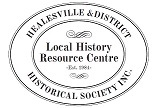By Bryn Jones
The following article was written as the Introduction to Bryn Jones popular book on the guest houses of Healesville “Free From City Cares” (2007). Although no longer in print, the Healesville & District Historical Society hold several copies, and the library also has a copy for reference.
Healesville owes its origin to gold, its development to timber, and its reputation to tourism. Gold plats no part in Healesville’s life today, timber has a continuing but demising role, but tourism and Healesville have had a long love affair, waxing and waning over the years but enduring, and currently prospering.
At the core of the tourist industry were the guest houses, and many there were over the years, ranging in the size and quality of such establishments as Gracedale House, Summerleigh Lodge and Kalymna Park, each catering for more than a hundred guests, to smaller, more modest but still substantial establishments providing accomodation for perhaps twenty or thirty guests. Others were active only at peak holiday periods, taking perhaps only the ‘overflow’ from their much larger neighbours.
Tracing the history of the guest houses is no always straightforward. Name changes sometimes took place when businesses changed hands or were refurbished or rebuilt. There are even slightly different spellings for the same premises in different advertisements; so ‘Chantonnay’ is sometimes ‘Chantonay’, and ‘Kalymna Park’, Kalimna Park’. Advertisements for some guest houses did not give an address but indicated they were ‘two miles from the station’ (in which direction?), ‘ten minutes walk from the station’ (carrying luggage, walking slowly, hurrying?), or were ‘on Fernshawe Road.’
Nevertheless, some one hundred and thirty ‘guest houses’ have been recorded in the the Healesville/Toolangi area, with perhaps in excess of seventy operating in the 1920s, the peak period of the guest house era.
And when is a ‘guest house’ not a ‘boarding house’? The latter description was used extensively even into the 1920s. A 1921 publication of the Healesville Tourist and Progress Association is entitled ‘Boarding House and Business Directory’, and includes the names of accomodation places later referred to as ‘guest houses’. In the absence of solid evidence, it may be suggested that with the rising popularity of tourism in the 1920s, a more ‘upmarket’ term was considered desirable. For whatever reason, ‘guest house’ became the more common usage in subsequent years.
* * * *
Today the accomodation field is being filled in the Healesville area by an outbreak of ‘bed and breakfasts’, supplementing the existing hotels and motels. Interestingly the number of ‘beds’ currently available does not come even close to those available in earlier years.
And what of those people who visited holiday towns? Were they visitors, guests, travellers, holiday-makers, tourists or day-trippers? In Healesville, at least, it seems that all those descriptions were used at some stage, though perhaps, loosely; yet probably there always has been, at least subconsciously, a distinction between those who came only for the dat and those who stayed for an extended period.
In the earliest days of ‘tourism’ in Healesville, because of the time the journey took and its relative discomfort, visitors stayed at least a couple of nights, and often more. As private transport became more common and faster, tourists were able to ‘cover’ the district in a day before returning later to their suburban homes.
Naturally, the local tourism infrastructure – accomodation providers, traders, entertainment venues and tourist businesses – preferred ‘the stayer’ to ‘the day-tripper’, but as both contributed to the local economy, both were welcome.

